|
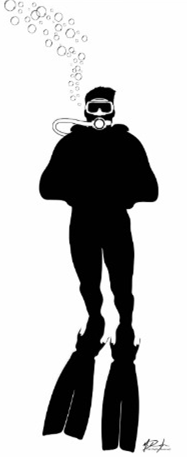

Dive Log
Back to

Back to

|
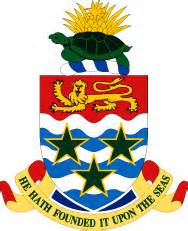
Grand
Cayman, British West Indies
July, 1980
Selecting a dive package is like going to a
smorgasbord; there are numerous selections and potential risk.
Area dive shops invariably offer island dive trips to Cozumel or
the Bahamas and that's fine if you like to go with a large group
to commercial dive resorts. But that defeated the purpose
of learning a sport that can put you anywhere in the world.
Or it may be that we were too much the loners to be associated
with large groups.
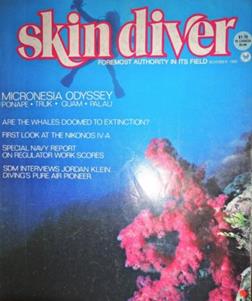 |
Our
selection criteria for dive locations was generally
based on inaccessibility of large cruise ships - no deep
sea port, limited/small dive operation, basic lodging
accommodations, etc. We subscribed to a number of
diving magazines all advertising destinations with
pristine diving and memories of a lifetime.
We settled on Grand Cayman for our
first saltwater dive adventure. The advertisements
boasted of seven miles of white sand beaches,
continental dining, a fresh water pool, two bars, and a
dive shop on the premises.
Grand Cayman is the largest of the three Cayman Islands
and the location of the territory's capital, George
Town. In relation to the other two Cayman Islands, it is
approximately 75 miles southwest of Little Cayman and 90
miles southwest of Cayman Brac.
|
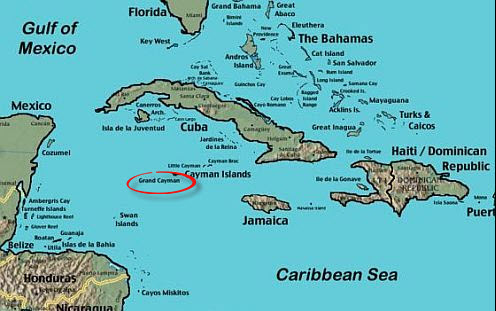
|
A bit of history...
Christopher Columbus sighted the Cayman Islands (after the Carib
word caimán for the marine crocodile ) on May 10, 1503
and found the two small islands (Cayman Brac and Little Cayman)
and it was these two islands that he named "Las Tortugas".
The first recorded English visitor was Sir Francis Drake in
1586, who reported that the caymanas were edible, but it
was the turtles which attracted ships in search of fresh meat
for their crews. Overfishing nearly extinguished the turtles
from the local waters.
Caymanian folklore explains that the island's first inhabitants
were a Welshman named Walters (or Watler) and his companion
named Bawden (or Bodden), who first arrived in Cayman in 1658
after serving in Oliver Cromwell's army in Jamaica. The first
recorded permanent inhabitant of the Cayman Islands, Isaac
Bodden, was born on Grand Cayman around 1700. He was the
grandson of the original settler named Bodden.
A
variety of people settled on the islands: pirates, refugees from
the Spanish Inquisition, shipwrecked sailors, and slaves. The
majority of Caymanians are of African and English descent, with
considerable interracial mixing.
England took formal control of the Caymans, along with Jamaica,
under the Treaty of Madrid in 1670 after the first settlers came
from Jamaica in 1661-71 to Little Cayman and Cayman Brac. These
first settlements were abandoned after attacks by Spanish
privateers, but English privateers often used the Cayman Islands
as a base and in the 18th century they became an increasingly
popular hideout for pirates, even after the end of legitimate
privateering in 1713. Following several unsuccessful attempts,
permanent settlement of the islands began in the 1730s. The
Cayman Islands historically have been popular as a tax haven. In
November 1794, ten vessels, which were part of a convoy escorted
by HMS Convert, were wrecked on the reef in Gun Bay, on the East
end of Grand Cayman, but with the help of local settlers, there
was no loss of life. The incident is now remembered as The Wreck
of the Ten Sail. Legend has it that there was a member of the
British Royal Family onboard and that in gratitude for their
bravery, King George III decreed that Caymanians should never be
conscripted for war service and Parliament legislated that they
should never be taxed.
From 1670, the Cayman Islands were effective dependencies of
Jamaica, although there was considerable self-government. In
1831, a legislative assembly was established by local consent at
a meeting of principal inhabitants held at Pedro St. James
Castle on December 5 of that year. Elections were held on
December 10 and the fledgling legislature passed its first local
legislation on December 31, 1831. Subsequently, the Jamaican
governor ratified a legislature consisting of eight magistrates
appointed by the Governor of Jamaica and 10 (later increased to
27) elected representatives.
In 1835, Governor Sligo arrived in Cayman from Jamaica to
declare all slaves free in accordance with the Emancipation Act
of 1833.
The Cayman Islands were officially declared and administered as
a dependency of Jamaica from 1863, but were rather like a parish
of Jamaica with the nominated justices of the peace and elected
vestrymen in their Legislature. From 1750 to 1898 the Chief
Magistrate was the administrating official for the dependency,
appointed by the Jamaican governor. In 1898 the Governor of
Jamaica began appointing a Commissioner for the Islands. The
first Commissioner was Frederick Sanguinetti. In 1959, upon the
formation of the Federation of the West Indies the dependency
status with regards to Jamaica ceased officially although the
Governor of Jamaica remained the Governor of the Cayman Islands
and had reserve powers over the Islands. Starting in 1959 the
chief official overseeing the day-to-day affairs of the islands
(for the Governor) was the Administrator. Upon Jamaica's
independence in 1962, the Cayman Islands broke its
administrative links with Jamaica and opted to become a direct
dependency of the British Crown, with the chief official of the
islands being the Administrator.
Following a two-year campaign by women to change their
circumstances, in 1959 Cayman received its first written
constitution which, for the first time, allowed women to vote.
Cayman ceased to be a dependency of Jamaica.
In 1971 the governmental structure of the Islands was again
changed with a Governor now running the Cayman Islands.
|
As was customary at the time with many
international flights, our trip to Grand Cayman required a
layover. For us, that meant a tiresome sit in a Texas
airport. From Texas we flew Antillian Airways -
serving complimentary rum punch before landing.
Although landing on Grand Cayman Island
was more spacious than most islands we have been to, it still
felt as though the pilot had put his landing gear down on the
very edge of the island, went immediately to full flaps, brakes,
and stopped not 15 feet from the end of the runway and the
ocean.
In 1980, the Grand Cayman International
Airport consisted of a Customs Office, baggage room, and a
sitting room. We were checked through customs after a few
preliminary questions and a quick search of our luggage.
Taxis were numerous and one had been sent by our hotel to pick
up any and all passengers...and any natives traveling that
direction. The drive was a young black man who was very
courteous and seemed willing to answer all our questions.
Our hotel was the Royal Palms, situated
ideally on the seven miles of white sands advertised in the dive
magazine.
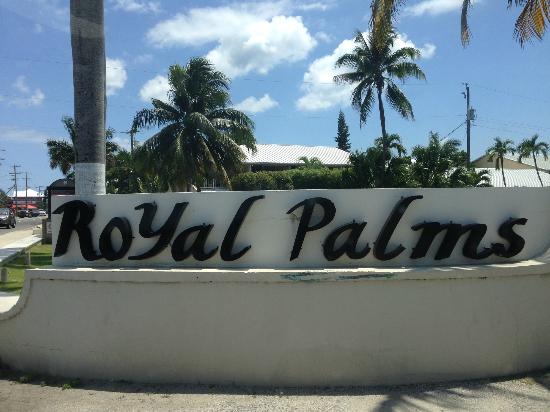

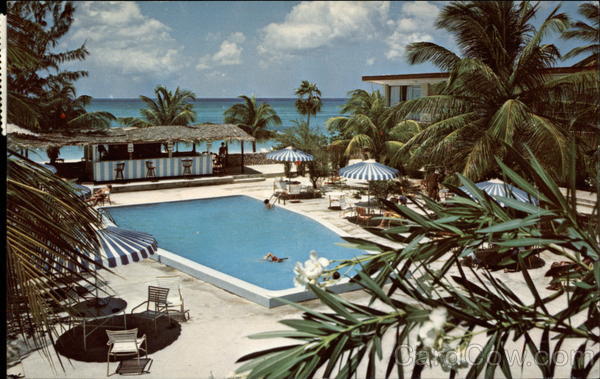
It it's hey day, the hotel must have been
spectacular with it's white concrete entrance, avenue of mature
palm trees, and its stately open appearance. And although
it showed evidence of wear, it still retained an air of dignity
and of conspicuous consumption.
The Royal Palms today is once again a
highly rated destination.
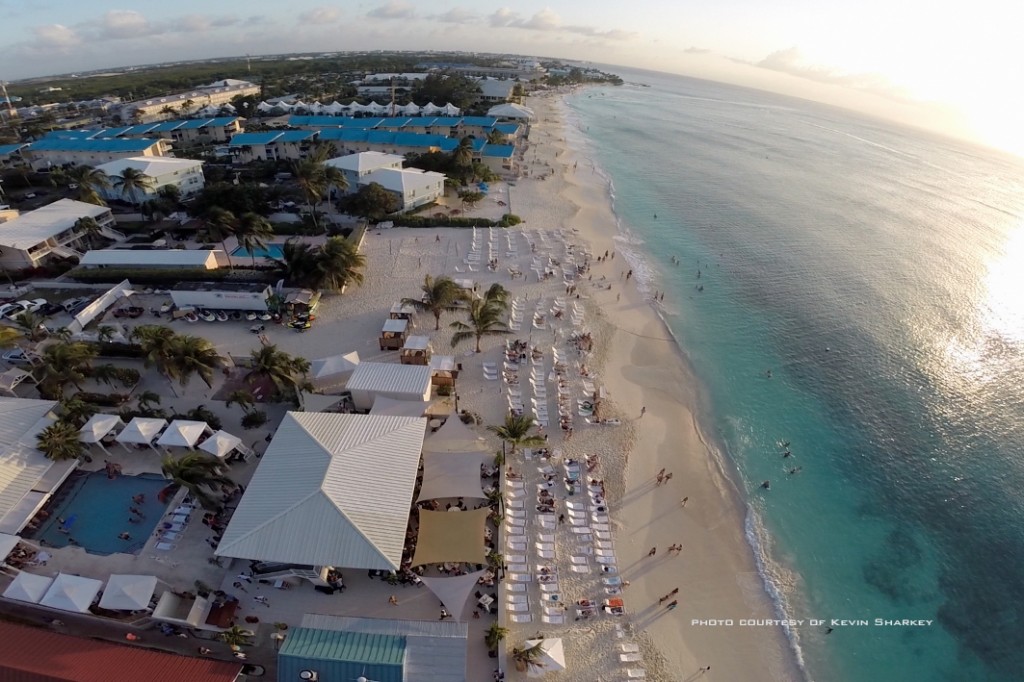
We checked in on a Sunday afternoon and
were given a brief tour of the facilities. Our room was on
the second floor of one of the older wings overlooking the pool
and courtyard. After settling in, we anxiously went to
inquire about our diving arrangements which were included as
part of the package. We were informed that the dive shop
was closed, and it was too late to make arrangements to dive the
following day.
We inquired if there was another dive
operation that may be able to help; "Well just down the
street there's a dive shop run by Bob Soto."
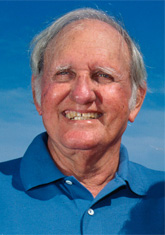 |
Bob Soto, established the
Caribbean’s first dive operation on Grand Cayman in
1957.
Soto’s introduction into diving came during World War II
when he went to work in the United States for the US
Navy. He started as a diver tender on a salvage
tug, progressing to assistant diver and then to hard hat
diver. After the war, Soto joined the Merchant Marines,
giving him the opportunity to dive in many places, such
as the Red Sea, the Persian Gulf and the waters off
South America. Returning home he realized that the
underwater scenery in Cayman was ‘second to none’.
Soto established a diving school in the Cayman Islands
for the tourism market. Soto created his own
equipment and promotional diving videos to assist the
Cayman Islands Department of Tourism and diving clubs
throughout the United States, as well as introducing the
first “live-aboard” trips. |
|
Soto, known as the “father of diving,” continues his
interest in marine and environmental conservation and
was instrumental in marine laws being put in place in
1986. He is very knowledgeable of the development
of these islands and the constant geographical movement
of the land and the sea. He continues to campaign
for more stringent laws to try and preserve marine life.
In 1996 he was given the ‘Marine Conservation Award’ for
his valiant efforts. Soto was made a Member of the
British Empire by Queen Elizabeth II for his various
life-long contributions. |
So off we walked towards Georgetown which
was a hike of 20 minutes or so, and one we would make
frequently. The shop was easily located and we inquired
within about arrangements for the following day. A
double-decked pontoon would pull up on the beach in front of our
hotel the next afternoon on their way to a dive spot with other
Soto divers on board.
We slept very little in anticipation of
our first saltwater dive, but we were raring to go in the
morning.
We were scheduled that afternoon to dive
Fish Pot Reef, just off Georgetown. The air temp was a
marvelous 95 with clear skies. This was the first time I
ever swam in saltwater. My heart was a flutter. This
is what it was all about!
The Dive Master gave an explanation of the
reef saying that we would be diving through tunnels of coral.
We entered the water at 2:55 PM. Visibility ran anywhere
from 90 to 100 feet with massive outcroppings of live coral
bordered by shoots of white sand. No words can adequately
describe the beauty.
There were brain coral six feet in radius.
Stag horn and elk horn reefs. And everywhere there were
fish too numerous to name and too many to catch in one glance.
Then fate stepped in to create another first.
On my first dive trip, on my first dive,
within the first ten minutes, I cut myself. We had been
going through several tunnels and I had just turned around to
check on Dad when I hit the palm of my hand on a piece of shelf
coral. The cut was a clean and deep "V" on my right hand.
It immediately began to bleed blue blood.
Perhaps I should explain. At different depths, colors are
lost to filtrating light. Red is one of the first colors
to go, so I was bleeding blue. I closed the wound with my
left hand and, showing it to Dad, I indicated that I did not
want to stop the dive. We surfaced 40 minutes later after
an otherwise tremendous dive. It was everything I had
hoped for.
After surfacing, it was impossible to
climb into the boat and remove my gear without releasing the
pressure on the wound. And being wet, the cut bled
profusely. The Dive Master cut a towel to make a wrapping
and by elevating my hand it bled very little. The only
pain was my pride. The return boat trip seemed much longer
with the numerous inquiries from the other divers.
Upon return to our hotel room and with
closer examination of the cut, Dad thought it should be stitched
and I agreed. We inquired in the lobby how to get to the
hospital and called for a cab. Still wrapped in the bloody
yellow beach towel, we headed for the "Casualty Room" - the
islands equivalent to an emergency room.
The concrete block building appeared
inside and out to be more like a bath house than a hospital.
The benches in the "Waiting Room" were also concrete built into
the walls and without padding. There was an "Admittance"
window at which we related for the umpteenth time how I had cut
my hand and were told to take a seat and wait.
There were fewer than half a dozen
patients in the room waiting for shots and prescriptions.
It was just after 5 PM when we were asked by the nurse to step
into the "Examination Room". She and several other, what
appeared to be nurse aids, examined the exposed flap of skin and
deliberated on whether or not the flap should be cut away and
allowed to heal on its own or stitched. Thank goodness, it
was decided that the nurse should contact the doctor who had
just gone to dinner and wouldn't be back for another hour.
So, we waited in the "Operating Room".
The room was unbelievable. In it
were chests with instruction sheets posted for the treatment of
numerous injuries. There was one gurney about five feet
long with two tanks at its head. The sheets were bloody
and the swabs and wrappings from the previous operation were
still on the floor. There was one air conditioner in the
only window running at full speed but making little headway.
To top it all off, we spent the the time waiting watching a
colony of ants drag dead butterflies across the floor.
The doctor arrived promptly one hour
later. he was in his late twenties or early thirties with
a reddish beard and curly hair and very English. We
learned that he was educated in England and interned on the
island.
After examining the cut, he concluded that
it would require stitching. The hand needed to be placed
on a flat surface and the only way to do that was to sit in a
chair next to the gurney, rotate my arm backwards and lay it on
the table behind my back. The shot of novacane as given
locally using a glass hypodermic with a LONG needle. The
doctor's hands shook slightly but the area was already somewhat
void of feeling. He then asked the nurse for 2-O silk.
"We don't have any." Then 3-0. "We don't have any."
They settled for black 4-O that I swore you could string a
tennis racket with.
Finishing with six stitches, he wrapped
the hand and said that he knew we were divers and it wouldn't do
any good to tell me not to get the stitches wet, but to dry the
hand off as quickly as I could after the dive. He wrote a
prescription for pain which we could get filled at the local
drug store. We thanked him and returned to the office to
pay our bill.
The island, being under British rule, had
socialized medicine. We asked the office clerk how much
the surgery cost. The girl said she didn't know but they
would send us a bill. We explained that we were from the
United States, but that didn't seem to make any difference.
A bill did arrive several weeks after our return. Fir the
stitches, removal of the stitches, the first prescription, and
medication, the cost was $17 if we paid by cash and $13 if we
paid by check.
The night was very restless when the
injection wore off and all the nerve endings came to life.
Come morning, there was no pain whatsoever. However, we
didn't think it would be wise to dive that day. Our plan
was to go into town and purchase a latex glove and surgical tape
to seal the water out. We purchased the only box of large
Playtex gloves the store had along with some tape and spent the
remainder of our time in Georgetown shopping. We bout a
couple of sharks carved from black coral and I bought an antique
Spanish piece of two (Spanish Reales were minted in 1/2s, 2s,
4s, and 8s - the legendary pieces of 8).
The remainder of the day we spent touring
the island. The hotel recommended a driver/guide named
Ruby. Ruby knew everyone on the island, or at least she
stopped and talked to everyone along the way. As a source
of information, Ruby was a gem. We stopped and sampled
native fruits from people's gardens; she was well versed in
native vegetation and the history of the island. Ruby
literally drove is to Hell and back.
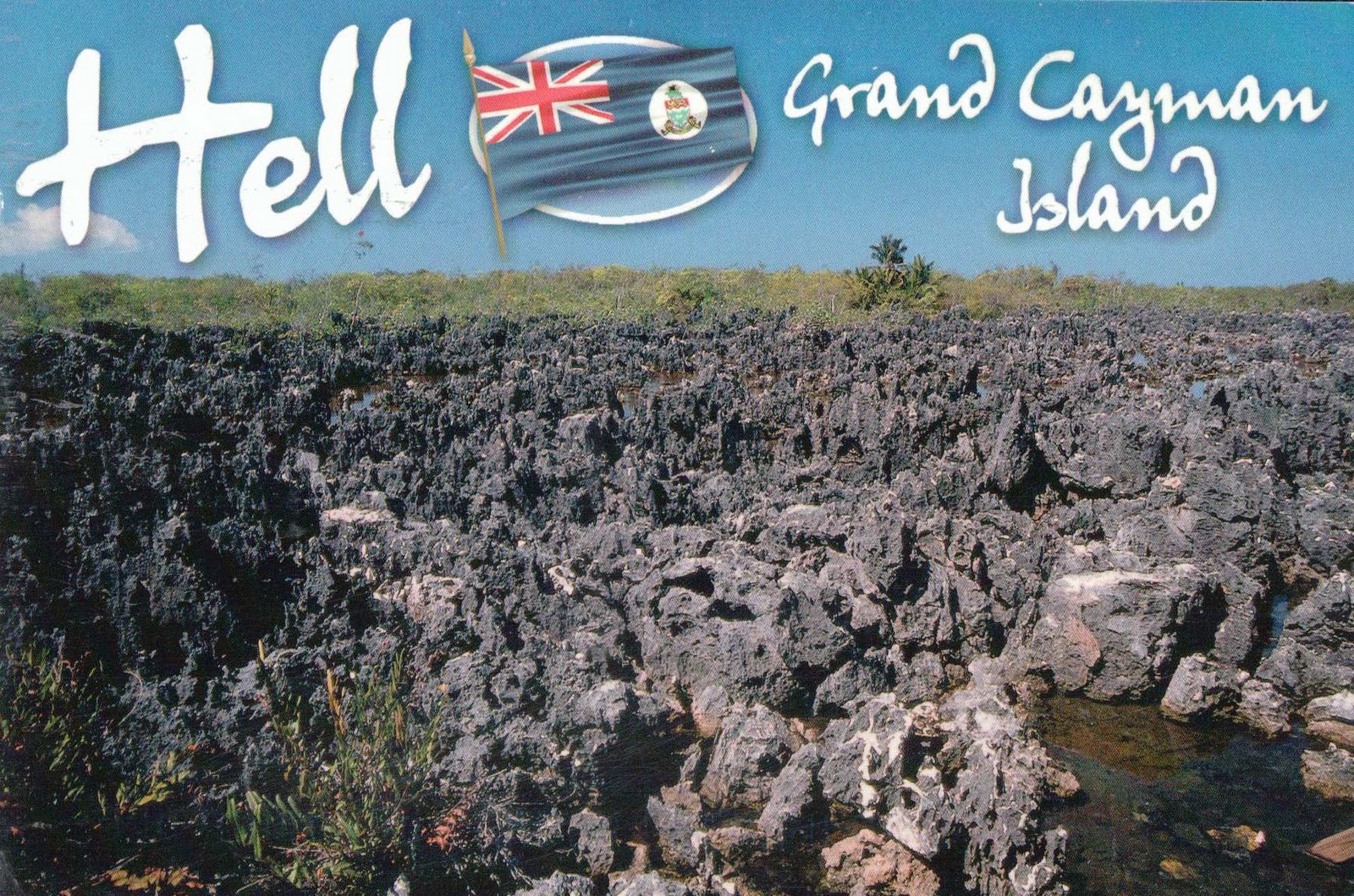 |
Hell,
at least in the islands, has a make-shift post office
complete with an official stamp (Hell, BWI). It is
not a town. It is an outcropping of strange
volcanic formations; like stalagmites of upward
projecting jagged spears of lava. If ever there
were in nature a depiction of Hell, Dante must surely
agree that this is it. We sent Mother a postcard
from Hell just to say we had been there and back.
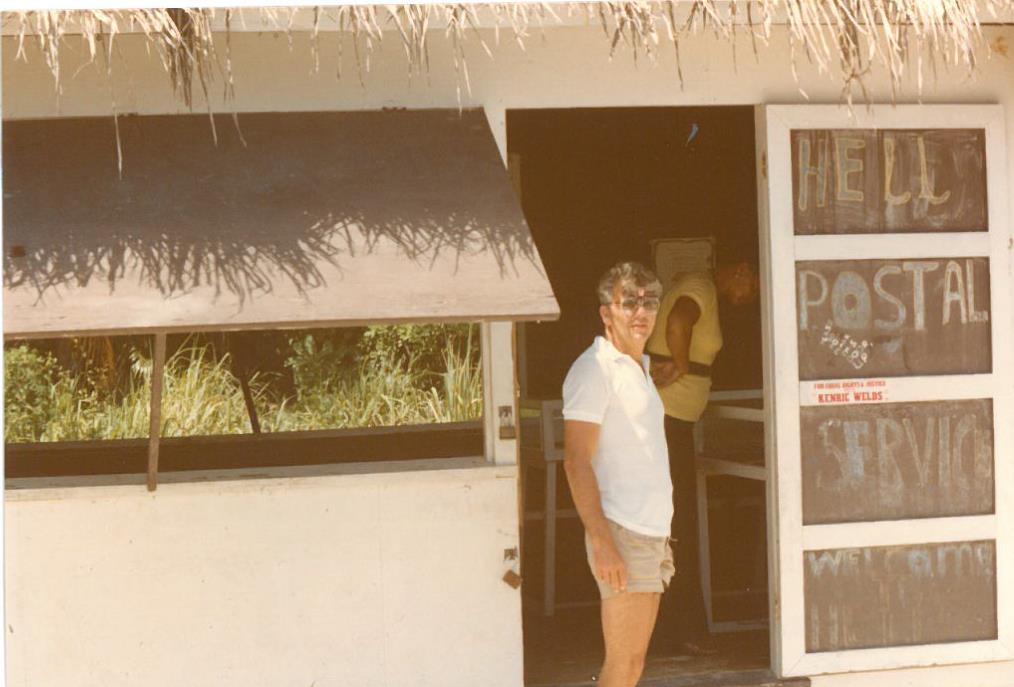
Hell Post Office with Dad
in the foreground and Ruby in the background |
In 2012, my brother and his wife went to
Hell. The Post office had changed considerably.
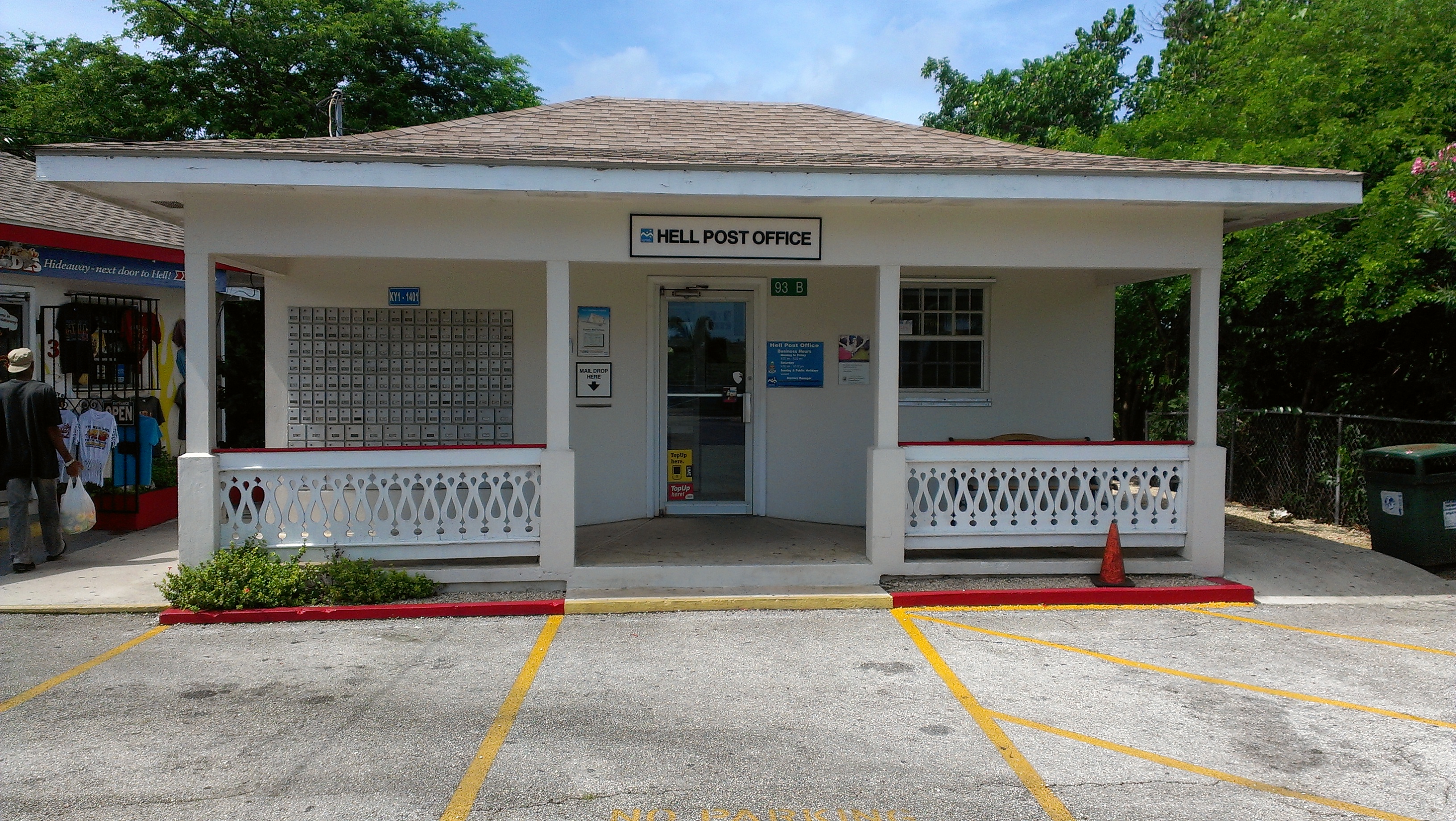
Included in our tour of the island was a
visit to the Grand Cayman Turtle Farms.
Cayman Turtle Farm was established in 1968 as Mariculture Ltd.
by a group of investors from the United States and Great Britain
as a facility to raise the green sea turtle for commercial
purposes. The intention was to supply the market with a source
of product that did not deplete the wild populations further. By
releasing turtles and facilitating research, any harm created by
removing turtles and eggs from the wild would be mitigated.
When were were there, the farm consisted
of a collection of holding tanks and nurseries operating much
like a fish hatchery. The Mexican government had an
ongoing study of an endangered species of sea turtle at the farm
although the guide didn't seem interested in talking about it.
The gift shop had a number of attractive
and attractively priced gifts from turtle shell glasses,
coasters, table tops, and polished shells to mummified/dried
baby sea turtles. We purchased some hand lotion for Mother
made from sea turtle oil. As it turned out, it was wise
that we didn't buy any other products since there was a ban on
articles made from sea turtles and they would have been
confiscated at US Customs; I have a polished sea turtle shell
undoubtedly adorning the wall of a customs storeroom to attest
to the fact.
Today, the Turtle Farm is a major tourist
attract with pools, wildlife encounter areas, water park, shows,
etc.
Having recovered from my coral encounter
and have had a day to rest, we began to plan for the morning
dive. We opened the box of rubber gloves only to find that
it contained two left-hand gloves and my cut was on the right
hand. Years of expensive education didn't go to waste, the
obvious solution was to turn the glove inside out.
The scheduled morning dive was to "Shark's
Hide" off Georgetown noted for the basket and barrel sponges
that are large enough to stand in. The weather was clear
and warm with water visibility up to 100 feet. I slipped
on the glove and taped it into place. We donned our tanks
and in we went - and in came the water into the glove. Oh
well. The dive consisted of a coral wall leading to the
open sea. Our average dept was 80 feet for a total dive
time of 20 minutes. All-in-all it was a great dive.
Sometime during the week - I don't remember
which day - we visited the ruins of the salt pans. African
slaves were imported to work the pans because the indigenous
Indians were too small to handle the burdensome loads. The
slaves were housed in huts shaped in a cube 6 feet by 6 feet
with a height of 4 feet. The huts were too small to stand
in or sleep comfortably. Several roofless huts still
remained as do the pans which were originally filed with sea
water and allowed to evaporate. The remaining salt was
harvested and shipped around the world.
Today, sea salt is still harvested from pans
and exported.
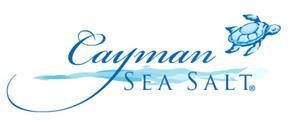
This being our first trip to the Islands, it
was also our first exposure to "island time." Being
regimented to time schedules and accustomed to looking at a
watch or clock every few minutes, we found ourselves waiting - a
lot. Other than the scheduled departure of the dive boat,
there is no sense of time and the natives move at an almost
sloth pace. Time is, "whenever" - whenever they feel like
it. Mangers have learned that giving a list of chores to
workers is useless. it is better to give them one task to
do and when completed they give them another. My advise to
divers is to take a dive watch and leave it with your gear at
the end of the dive. We made a
number of dives to reefs with exotic names - Eden Rock, Drop
Off, Island Shoot, and Surfside Reef - before diving our first
wreck; the Oro Verde.
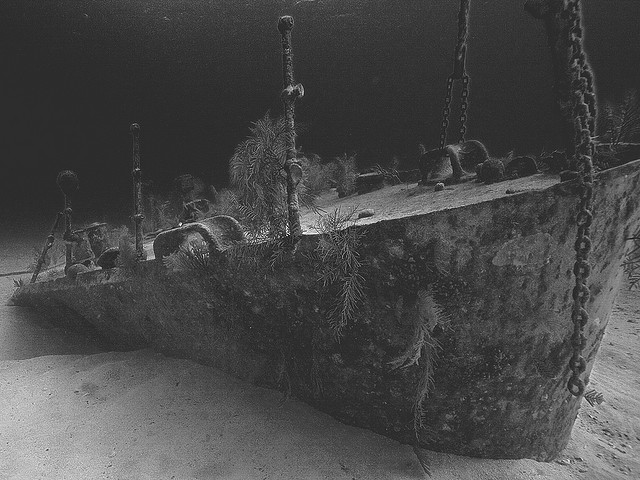 |
The
184' Oro Verde (meaning green gold) was a liberty tanker
sunk in May 31, 1980 to serve as a dive site and as a
base for a reef. The ship lays on its
starboard side in about 50 feet of water, easily
accessible from a dive boat. The hull was left
open for fish and divers to explore. Not the
Spanish galleon one would hope to dive, but interesting
nonetheless.
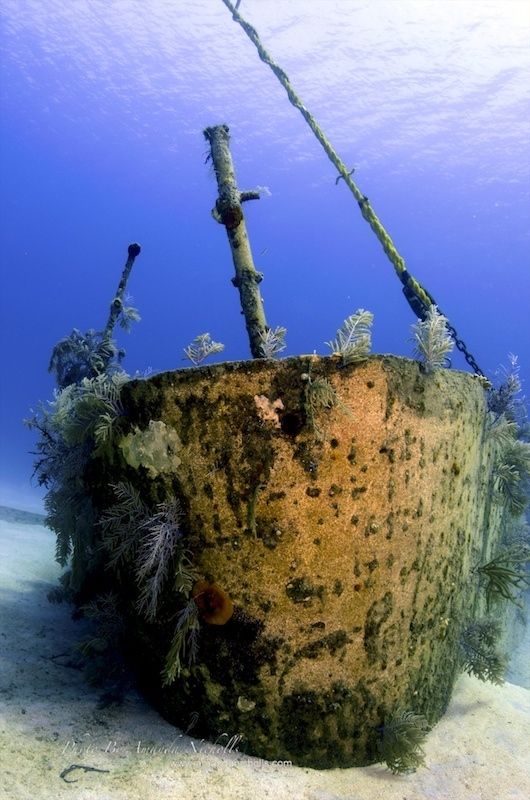 |
The boat was just beginning
to attract colonies of fish including one large
angel fish with a hole through its body - the
result a a spear gun. It obviously didn't
hold a grudge since it was first to the
breadline; bread being taken down in plastic
bags by the Dive Master to feed the fish. |
|
| A quick
explanation of the operations on a dive boat might be in
order for the uninitiated. Dive boats range from
pontoons to strafed-hulled open cockpit boats, to wooden
launches, to cabin cruisers. Anything that floats
and has a motor to transport divers in some relative
safety and comfort to a dive site will fulfill the dive
boat requirement. The FLAG Diving operation that
we used from the hotel operated two double-decked
pontoons with a walk-on bow and a platform at the stern
to enter and exit the water. Each boat normally
had two operators; one piloted the boat and may or may
not also dive with the group, the second was the Dive
Master who oversaw the dives.
Our Dive Master was a young man named
Derrick whose father was in the fishing industry in
Texas. The duties of the dive boat personnel were
many - skipper, mechanic, dock hand, pilot, social
worker, and instructor. The boats were usually
equipped with tanks so we carried only our personal gear
on board - mask, fins, snorkel, regulators, and buoyancy
control device (BC).
For the most part, the dive sites
were marked with permanent moorings. Where there
were no moorings, the crew were VERY careful to make
certain that we anchored in a sand shoot to not damage
the coral. |
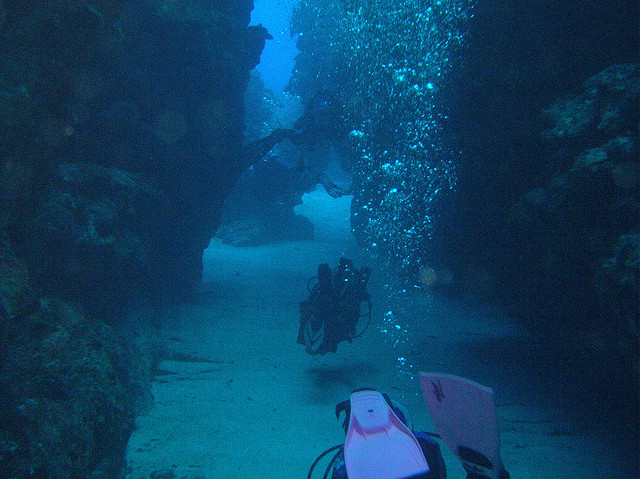
At 10:47 AM we climbed out of the
water from our last dive of the year and our first
saltwater dive adventure. We packed our bags and
taxied to the airport that afternoon for the flight
home.
The final note in the
dive log
says it all;
"Last Dive - Great Week -
Fantastic Diving!!!" |
Trinity Caves was a unique dive.
It was like diving a cave except that the coral formed
the stalactites and stalagmites. I kept my hands
to my side this time.We
made one last trip to George Town to pick up a few
souvenirs and to stop by the hospital to have my
stitches removed. This trip began a long tradition
of collective dive T-shirts. The collection of
shirts from various islands inevitably sparked
conversations.
The last dive of any trip is the
most difficult; you want it to last as long as possible.
Our last dive was at Flamingo Tongue; a large coral reef
in 30 feet of water. The reef is named after the
snail that inhabits the waters.
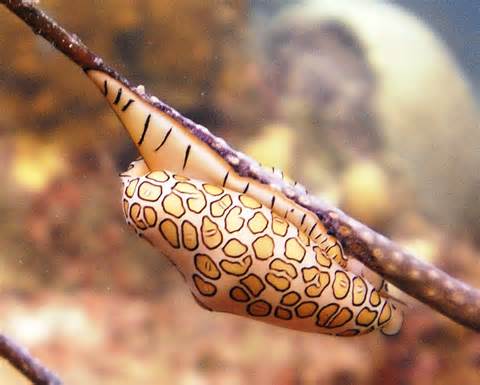 |
Back to

Back to

|